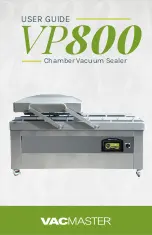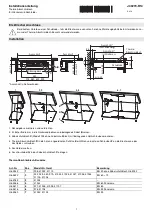
E4
How to Use Your Skillet
1. Turn temperature control to “OFF”.
Plug temperature control probe
securely into receptacle on skillet,
plug into standard 120v AC outlet
and turn temperature control to
desired setting.
2. The temperature control indicator
light will come on when you set or
adjust the temperature. Once the
desired temperature is reached, the
indicator light will cycle during use,
indicating the selected temperature is
being maintained. (When adding
food, the indicator light will come on
briefly as the overall cooking temperature
is reduced.)
3. Preheat the skillet with the lid on for
10 – 15 minutes or until the indicator
light goes out.
NOTE: The cooking
temperatures listed in this user manual
are estimates. Adjust the cooking
temperature slightly up or down to
achieve the results you prefer.
4. A steam vent is located on the lid. The
steam vent allows steam to escape while
cooking with the lid in place.
CAUTION: Escaping steam is hot! Be
careful when removing or lifting lid.
NOTE: If heating oil, always leave the lid
off. If oil smokes, immediately turn skillet
“OFF” and allow to cool.
Helpful Hints
• Before using the skillet for the first
time, lightly brush cooking surface
with vegetable oil. Heat, uncovered,
to 300°F. Turn “OFF” and cool
completely. Wipe away excess oil.
• Use only nylon or heat-proof plastic
cooking utensils. Metal utensils may
scratch the non-stick surface.
• This skillet is not designed to deep
fry. To pan-fry, do not use more than
1 cup of oil. Select a vegetable oil or
peanut oil for frying, Butter and
olive oil should only be used to saute
foods on a lower temperature setting.
Temperature and Cooking Guide
BURGERS
⁄ lb.
3 to 9 minutes/per side (medium)
300°F
STEAK
1" thick, boneless
9 to 12 minutes/per side
300°F
CHICKEN
boneless breasts
6 to 7 minutes/per side
300°F
FRENCH TOAST
3 to 5 minutes/per side
325°F
PANCAKES
1 to 3 minutes/per side
300°F
EGGS
Fried
2 to 3 minutes/first side
300°F
1 to 2 minutes/second side
Melt 1 to 2 tsp. butter or margarine in skillet
Poached
1 to 6 eggs
2 to 3 minutes
250°F or 300°F
Pour 2 cups water and 1 tsp. cider vinegar
in skillet. Heat to boiling. Break each egg
into a bowl; slip into water. Cover and cook
2 to 3 minutes.
Scrambled
3 to 4 minutes
300°F
Melt 1 to 2 tablespoons butter or
margarine in skillet. Add eggs, cook, stir
gently, until set and cooked.
BACON
5 minutes/first side
300°F
1 to 3 minutes/second side
SAUSAGE LINKS
8 to 10 minutes
300°F
SAUSAGE PATTIES
6 minutes/first side
300°F
5 to 6 minutes/second side
FOOD
AMOUNT
TIME/DIRECTIONS
TEMP.
E5
How to Clean Your Skillet
CAUTION: Skillet is hot. Handle carefully.
1. Always allow the skillet to completely
cool before cleaning.
2. Unplug cord from wall outlet, then
remove temperature control probe
from appliance. Wipe probe clean with
a dry towel.
3. Immerse the skillet and lid in warm,
soapy water and wash with a soft cloth.
4. Rinse well and dry. All parts, except the
temperature control probe, are fully
immersible and dishwasher-safe.
NOTE: DO NOT use steel wool, abrasive
cleaners, or metal scouring pads on cooking
surfaces as this will damage the non-stick
coating.
WARNING: Do not immerse temperature
control probe in water or other liquid.
GE168998/428-1252 E/S.qxd 5/14/04 10:19 Page 5
























